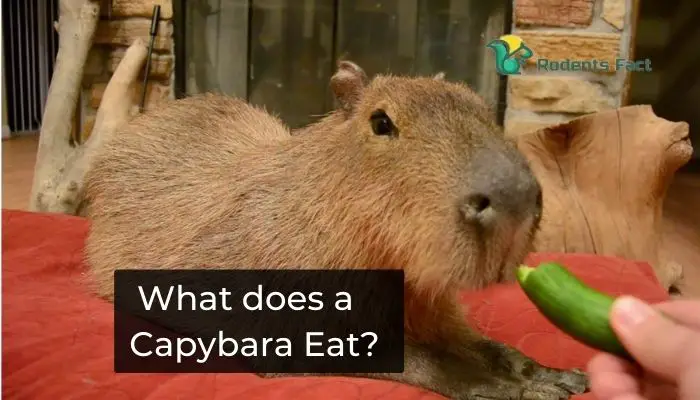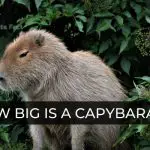Capybara Diet: What does a Capybara Eat?
Capybaras are common near the water bodies but why do they live there? Well, it’s not only because they need to swim; their food habits depend on the water too!
The diet that a capybara follows is closely connected to the waterline and this is why they stay near the waterway.

So, what does a capybara eat? Their eating practice depends on the season, geography, age, weather, and a lot more. Don’t you want to know about it?
Food Habits of a Capybara
Capybaras are herbivores and so they eat vegetation. However, they are more into the vegetation that is connected to the water sources.
Along with this, the vegetation mostly lines the other aquatic plants. To start with, these large rodents are into grass and water plants. However, food habits differ a little depending on the geographic location of the animals.

Here, we have summed up the diet depending on the season. Yes, they don’t differ a lot but the amounts they eat in the different seasons have differences.
Capybara and the Diet
The digestive system of this rodent includes vegetation, as we have mentioned above. They have long and sharp teeth. As a result, they can easily graze on grass and all the water plants. So, what are capybaras’ favorite foods? You can already guess that! Yes, grass and water plants!
However, just like the geographic locations, the seasons also have an important role when it comes to feeding themselves. The digestive system of these animals is extremely efficient. And in the diet plan, there are only three to six species of plants.

Capybaras have two types of scent glands. On the snout, they have Morillo and there is an also anal gland. Both the genders have these two glands available.
However, the male capybaras have larger Morrillos than the female capybaras. Also, the female rodents use their anal glands less frequently than the male ones. The anal glands of the male are lined with their hairs.
🐿️ Read About Groundhogs: Male Groundhogs vs. Female Groundhogs!
Wet Season Diet
People get confused about the diet plans of a Capybara. So, what does a capybara eat in the rainforest and South America? Well, grasses and plants are their basic food. Along with these, they love leaves and stems.

Vegetables are their favorite diet. Also, they eat fruits. However, fruits are not their hot favorite. And so, they are seen eating a few fruits. You can feed them apples, bananas, etc. They live on the aquatic plants and this is why they live near water like the rivers and lakes.
With water plants and aquatic plants, they also go for tree bark in situations. Sugar cane and tubers are their favorite.
Along with this, cabbage is something they are very fond of. We can easily comment that the diet of a capybara is quite healthy.
The vegetation they prefer is high in protein. Also, they are rich in energy too. In the wet season, the resources of food are abundant as so, they can be choosy about their food.
And in this season, 80% of their food is five or close species of grasses as we have mentioned already.
Leaves, herbaceous, reeds, water hyacinths, crops, grains, seeds, and other vegetables are what they eat during wet seasons. But how do they collect food?
Do they search for it alone or are they social with other animals? Well, check out more about it capybaras hang out with other animals!
Dry Season Diet
The diet plan of the capybaras is almost the same in the dry season too. But the food availability in the dry season is reduced in the dry season. Also, the food quality isn’t great. They do not get a lot of available plants in the dry season.
The plants they eat during the wet season usually lose their nutritional value in the dry season. As a result, they are not consumed during that period. They prefer going to reeds and grains mostly in this season.
For the deducted food availability, they also settle for melons and squashes as their diet. Yes, they are very selective when it comes to their food at this time of the year. If you pet one, what do you feed a capybara?
The best thing you can feed them is high-quality grass. Along with these, reeds, grains, melons, and sugar cane will be alright for them!
NOTE: However, it’s necessary to keep in mind that capybara does not eat high-fat food. From peanuts to sunflower seeds, they are not the right diet for these animals. Also, never go for birdseed. Food with added sugar is strictly prohibited.
The same goes for candy or junk food too. It’s always better to skip sweet fruits but you can feed them at times. This rule is for the people that try to feed or pet capybaras. Other than that, capybara knows their food habits when they are on their own.
The Unusual Diet
We have mentioned that capybaras depend on vegetation. But they have an unusual diet on their list. When almost all the food we have seen on their list till now seems healthy, this might amaze you.
🐿️ Read More: Is A Guinea Pig Or A Hamster Better? | 7 Factors to Consider
They are Coprophagous. This refers that Capybara eating their own feces. This nature is practiced among the rodents like the capybara and guinea pigs, lagomorphs like the hares and pikas, baby elephants, hippos, and a few nonhuman primates.
But why do capybaras eat their own poop? Capybara feces are a source of bacterial gut flora. And this one helps in digesting the cellulose in the grass they eat for forming their normal diet.
It also helps in extracting the maximum protein from the food they have eaten the whole day. To absorb nutrients from their eaten food, eating feces in the morning helps their digestion process.
Vitamin- C and Capybara Diseases
Though they eat a lot of healthy plants, seeds, and vegetables, they cannot synthesize vitamin-c. Yes, their body is unable to synthesize essential Vitamin C by themselves. This feature is common when we talk about the relative of the Capybara, the Guinea Pig.
However, if they are kept captive, they must eat fruits and vegetables that are rich in Vitamin C. Carrots, apples and such food can result amazing for their health.
If they are not supplemented with Vitamin-C, there are chances of the Capybara developing gum diseases such as scurvy. Their food habit can be a reason for their deaths too. Learn more about how long do capybaras live!
Do Capybaras Eat Meat?
We have mentioned that capybaras are herbivorous. But at times, they are also seen eating meat- reported by some! Some reports say they eat small mammals. Along with this, reptiles and fish are also in their diet chart according to sources.
In some rare cases, they feed themselves birds too. However, there are no proven reports on if the capybaras eat meat.
According to proven scientific sources, capybaras are herbivores and they only feed themselves plants and vegetation. If you see a capybara in the wild, it will mostly eat more than the regular capybaras.
The Amount of Food Capybaras Eat
When it comes to the amount of food a capybara eats a day- it might amaze you. Well, an adult capybara is capable of feeding itself six to eight founds of grasses every day!
If you check the weight of a capybara, they can eat about 3% to 4% of their weight every day! This is unusual for us but almost very common for rodents. The jaw hinge of this animal is non-perpendicular.
As a consequence, they need to chew food by grinding the food back and forth. They cannot go for side-to-side grinding. This is why they can chew the plants and even the tough plants without any complications.
Wrap Up
We have tried to sum up the entire diet of a capybara regardless of the season, the climate, the geographic location, and their age!
No matter whether you pet a capybara or not- you might want to feed them when you see one! And this is when you must keep in mind their diet chart. Their diet is healthier than humans- do you doubt it?




